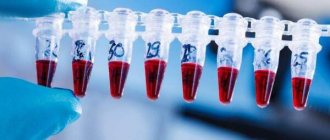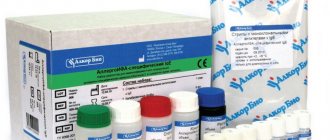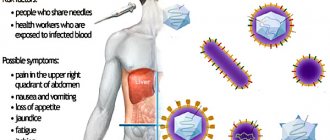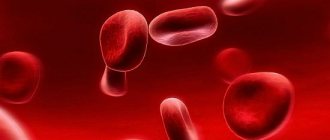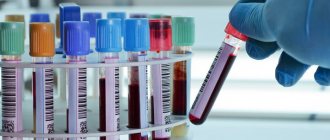Giardiasis is a disease that occurs when single-celled protozoa Giardia enters the human body. Giardia is a cell whose structure resembles a pear. At one end it has 4 pairs of flagella (organelles of movement) and a suction cup, allowing it to firmly adhere to the intestinal epithelium.
Giardia reproduces by division. The division process lasts 5–20 minutes, so for the development of the disease, it is enough for 1–10 protozoan cysts to enter the body, and after a short time there are many more of them. Giardia can be detected in a child or adult through symptoms or laboratory tests.
What to do in such a situation? To get started, we recommend reading this article. This article describes in detail methods of controlling parasites. We also recommend that you consult a specialist. Read the article >>>
This is what Giardia looks like
What is Giardia
Giardia are not worms, but microscopic parasites of the protozoan class. The place of Giardia parasitism is the upper parts of the small intestine. Giardia is attached to the mucous membrane by the front part of the body, and the rear end is free.
Trophozoites remain fixed in one place for a short time. They are often detached from the villi and reattached to them, but in a different place or become free. With intensive invasion, they can penetrate into the villi tissue.
Trophozoites periodically detaching from the mucous membrane encyst or degenerate. Experimental studies on dogs have established that 10-15 days after infection, the bulk of trophozoites are localized in the jejunum and occasionally in the duodenum.
Analysis for giardiasis. Giardia is one of the most common human parasites that lives in the upper parts of the small intestines. Modern data on the morphological and biological characteristics of Giardia indicate their exceptional adaptability to living in this particular area of the gastrointestinal tract.
Subsequently, the Giardia population moves from the proximal to the middle or to the middle and distal parts of the small intestine. The formation of cysts (encystation) in the first 10-15 days occurs in the jejunum, rarely in the duodenum, and at a later date in the middle and distal parts of the small intestine.
This depends on the size of the Giardia population, the severity of pathological changes at the site of parasitism and the duration of the invasive process. Cyst discharge during giardiasis is intermittent.
Rules for taking the analysis
There are no special conditions for donating blood, except one. A blood test for Giardia should be taken no earlier than 10-15 days after symptoms appear. Otherwise, antibodies may simply not have time to develop, and even in the case of a pronounced immune response, a serological test will not give a reliable result. The doctor may have the opinion that either seroconversion has occurred, or giardiasis is seronegative, that is, without the production of antibodies. This situation is very typical for profound immunodeficiency, for example, with HIV infection.
Ways of infection with Giardia
The source of Giardia infection is people infected with this parasite. In the intestines of infected people, adult lamblia become covered with a dense membrane and turn into so-called cysts, which are excreted in the feces. Giardia cysts are very resistant to external influences and can survive for a long time in the external environment.
If cysts that get into water or food are swallowed by a healthy person (only 10 parasite cysts are enough to become infected), within a short time they will turn into adult Giardia, which will begin to multiply quickly.
Parasites are transmitted mainly from person to person. Having formed in the intestines of an infected person, Giardia cysts are excreted in the feces. They are resistant to external influences and can survive in the external environment for a long time.
In children's groups, a child may become infected with Giardia through dishes and shared toys. Cysts that enter the human body with food or water will turn into trophozoites in a short time and begin to multiply rapidly.
What properties of the pathogen must be taken into account in diagnostic methods?
The Russian doctor D.F. was the first to describe the cause of the disease. Lambl in 1859, the name of the parasite and the disease is associated with his name. In European countries, this role is given to the Frenchman A. Giard, so you can also find the name of the disease as “giardiasis.”
Giardia is the simplest unicellular flagellated microorganism. It parasitizes mainly in the initial parts of the human small intestine (duodenum and jejunum). It can exist in two forms: vegetative (trophozoite) and spores (cysts). Under a microscope, they are easy to recognize by their characteristic pear-shaped shape, suckers and four pairs of flagella.
Giardia feeds through the membrane by absorbing necessary substances from the intestines, taking them away from the body of an infected person. Reproduction is carried out quickly by division, doubling the number every 10–12 hours. Giardia cysts are equipped with a double-circuit capsule and are oval in shape.
They are found only in the large intestine and are excreted with the patient’s feces into the external environment, where they remain viable for a long time. This feature makes it relatively simple to organize the diagnosis of giardiasis by examining stool. A person becomes infected through unwashed hands, vegetables from the garden, water, contaminated food, and through the fecal-oral route at home. Possible carriers of cysts are domestic animals, flies, and cockroaches.
What is giardiasis
Giardiasis is one of the dangerous contagious diseases that occurs asymptomatically in humans. The disease is caused by protozoa - Giardia, which move in the intestines thanks to small flagella. Infection occurs through drinking water containing the pathogen or through contact with a sick person.
Most often, a child becomes infected with Giardia, since it is young children who neglect the rules of personal hygiene. But the disease can also be found in adults. Doctors especially insist that in case of any digestive disorders, parents do not self-medicate, but go to the clinic to be tested for giardiasis in children.
The peculiarity of giardiasis is that the disease may not produce any symptoms for a long time, and a single diarrhea or vomiting is not perceived by a person as a serious illness. Often, patients attribute them to poisoning and treat themselves, without even seeing a doctor.
This will protect the child from serious diseases that provoke Giardia in the child’s body, especially with weak immunity. Giardiasis is also tested for those children who lose weight for no reason.
In order to correctly diagnose the disease and begin treatment, it is necessary to undergo a series of diagnostic tests for giardiasis. Such studies include a blood test for Giardia.
Consequences of giardiasis
Giardia should be taken seriously; it causes diseases associated with the stomach. The gallbladder, intestinal apparatus, and musculoskeletal system suffer. The disease affects the nervous system. As a result, the patient experiences poor sleep, anxiety, headaches, arrhythmia, fainting, and irritability.
If the disease is chronic, children and the older generation experience skin disorders: pale condition, uneven coloring, damage to the lip area. A child and an adult may notice peeling of the skin and the presence of cracks on the body.
Symptoms and signs of giardiasis
Symptoms of giardiasis can be very similar to the symptoms of food poisoning or some other dangerous diseases for which the patient needs urgent medical attention. In the vast majority of cases, Giardia infection does not cause any symptoms, and the infection itself disappears without any treatment within a few weeks or months.
Analysis for giardiasis. Infection with giardia leads to the development of giardiasis, in which there is a prolonged disruption of the digestive process and other symptoms. For this reason, without adequate treatment, giardiasis can lead to severe exhaustion. Less commonly, Giardia colonizes the biliary tract and can cause serious liver damage.
The first symptoms of giardiasis may appear 1-2 weeks after infection, when the parasites have already managed to multiply and disrupt intestinal function. Giardia primarily affects the small intestine, where food is digested and absorbed.
The main symptoms and signs of giardiasis are:
- not very frequent, but prolonged diarrhea (diarrhea) in which very foul-smelling stool is released that sticks to the toilet or potty (a sign of the presence of undigested fats in the stool). Diarrhea may last for several weeks;
- sudden temperature of 38 C or higher, weakness, chills;
- sharp pain in the abdomen (usually in the navel area);
- prolonged nausea, periodic vomiting;
- the appearance of a pink-red itchy rash on the skin;
- weight loss.
Analysis for giardiasis - diagnosis of giardia
It is impossible to visually detect Giardia during bowel movements due to their microscopic size and habitat in the upper intestines. When it enters the large intestine, a sexually mature individual turns into a cyst and, in this form, leaves the body of its owner for further spread.
All children with underweight and delayed physical development, those attending children's groups, persons with diarrhea of unknown origin, chronic pathologies of the digestive system, constant rashes on the body, frequent obstructive bronchitis and bronchial asthma must be tested for giardiasis.
Families and their close relatives are subject to mandatory examination when Giardia is detected in one of its members. A generally available method for detecting giardiasis is to examine fresh feces under a microscope with preliminary staining with Lugol's solution.
The serological method helps determine the level of antibodies (substances produced to protect against foreign elements) in the blood. After complete cure, the level of antibodies decreases only after a few months, so it is necessary to conduct a repeat study to monitor therapy.
Features of the life cycle and the short period of existence of vegetative forms in feces require multiple studies to confirm the diagnosis. It is best to submit the material 3–7 times with breaks of 1 week.
Duodenal intubation, when a special probe is inserted through the mouth directly into the duodenum, with further examination of its juice and bile for Giardia, gives a 100% positive result in case of infection. The use of the method is limited due to its traumatic nature and psychological stress, especially in childhood.
An alternative and non-traumatic method for detecting giardiasis is an immunological study. It allows you to detect antigens (specific elements) in stool. Enzyme-linked immunosorbent assay (ELISA) is informative already on the 10th day after infection.
The most reliable method for confirming giardiasis is the polymerase chain reaction (PCR). It can detect parasite DNA in biological secretions. The method is actively used for express diagnostics (stool test) of helminthic infestation.
Giardiasis in pregnant women
When a woman is in an interesting position and her immune system is vulnerable, the risk of contracting giardiasis increases. If the diagnosis is confirmed, proper treatment begins. The disease during pregnancy dangerously harms the baby, it is advisable to identify it in advance. The infection blocks the flow of necessary substances into the body. Abnormalities in the fetus may occur. Red blood cells decrease in blood. Due to insufficient oxygen entering the body, fetal hypoxia occurs. Before pregnancy, a woman needs to undergo a complete examination to ensure the absence of the disease.
Indications for blood testing for Giardia
Testing for giardiasis reveals the presence of parasites in the body. This may be a microscopic examination of stool, but cysts (the spore form that microorganisms acquire when they find themselves in the rectum) are not always detected, but only in 50-70%.
The symptoms are not specific, therefore, in order to prescribe adequate treatment, the doctor needs to know for sure what causes the digestive problems.
Therefore, a serological blood test for antibodies is usually prescribed in conjunction with a stool test. The doctor will prescribe this test if he suspects the disease.
The clinical manifestations of the disease are as follows:
- prolonged diarrhea,
- stomach ache,
- increased body temperature and chills,
- skin rashes, vomiting.
Laboratory diagnostics
Polymorphism of clinical symptoms and frequent co-occurrence with other infections make it difficult to diagnose giardiasis invasion. To correctly diagnose an invasion, the following research methods are used:
- fecal analysis
- analysis of duodenal contents
- blood tests - ELISA, PCR, general, biochemical
The most commonly used method in the laboratory diagnosis of giardiasis infection remains microscopy of feces and duodenal contents. A urine test is not done for giardiasis.
Parasitological research plays a primary role in diagnosis. The main drawback of the microscopic method is the difficulty of differentiating Giardia and other flagellates living in the intestine and the cyclical nature of cyst excretion.
Methods of enzyme immunoassay and immunofluorescence are considered promising in laboratory diagnostics. They have high sensitivity (60-95%) and specificity up to 92%. In clinical practice, serodiagnosis is used as a complement to traditional methods.
The serological method makes it possible to detect the presence of a parasite by the presence of
specific antibodies (immunoglobulins G and M) to parasite antigens , determine the stage of infection, and make a prognosis for the development of invasion, but does not answer which pest has settled in the body .
Serodiagnosis is carried out to monitor treatment. , all three methods are used to make a diagnosis . In some modern laboratories, feces and blood are examined using the polymerase chain reaction (PCR) to detect the DNA of single-cell parasites.
The essence of a blood test for lamblia
Testing for giardiasis is a serological test using enzyme-linked immunosorbent assay (ELISA). This means that high-precision instruments in a clinical diagnostic laboratory will identify antibodies in the blood serum that are produced by the immune system in response to damage to the body by this parasite. They can be detected as early as 2 weeks after infection.
When L. intestinalis multiplies in the intestine, the specific antigen GSA 65 is produced in large quantities. In feces it is determined by the monoclonal AT method. Specific ATs of the IgM class can be detected in the patient’s blood serum using ELISA already on days 10-14 from the onset of invasion; their presence in diagnostic titers indicates acute giardiasis.
Recently, for laboratory confirmation of giardiasis, immunological research methods have been used, based on the detection of pathogen antigens in feces or specific antigens in blood serum.
The use of PCR to detect Giardia DNA in biological substrates is a highly effective diagnostic method, but is used mainly for scientific research.
Results
Giardia is a parasite that enters the human body through contaminated or unprocessed foods, contaminated water, as well as through household items, and through contact with carriers of the infection. As a result of their penetration, severe intoxication develops, accompanied by characteristic symptoms (diarrhea, vomiting, high fever, abdominal pain, etc.).
To differentiate giardiasis from other parasitic diseases with similar symptoms, a blood test for giardia and helminths is prescribed. Before donating blood for Giardia, the patient needs to prepare. The training rules provide for a change in diet and temporary refusal of medications.
Blood sampling is carried out exclusively on an empty stomach. Giardia is detected using enzyme-linked immunosorbent assay (ELISA). Based on the results of the study, three-stage treatment with antiprotozoal medications is prescribed. Timely diagnosis will help avoid unwanted consequences.
Blood test for lamblia
The essence of the ELISA diagnostic procedure is a study of venous blood, during which the presence of Giardia in the body can be reliably confirmed or denied. Deciphering such analyzes with an error of only 1 percent. Total antibodies are a good way to determine current or past Giardia infection.
The presumptive diagnosis is confirmed by antibodies of type M, which are found in the blood of patients suffering from Giardia. They appear in the body in response to the aggression of antigens. Giardia blood shows antibodies of this type already at the end of the second week from the moment a person is infected. A little later, tests for Giardia show other antibodies of type A and G.
Preparing for a lamblia blood test
Analysis for giardiasis shows the presence of immunoglobulins only three weeks after infection. Also, the antibodies produced can remain in the blood for a long period of time after recovery.
Therefore, a serological test cannot be called one hundred percent accurate - rather, its interpretation and results will only be of a clarifying nature. Antibiotics can significantly affect blood counts, which will lead to incorrect interpretation of the results and antibodies to Giardia antigens will not be detected.
Failure to comply with the rules for taking and conducting immunological studies can fundamentally distort the clinical picture, therefore it is very important to know how to prepare for a blood test for Giardia in children and adults.
Rules for preparing for the test for Giardia in the blood:
- do not eat 10 hours before blood sampling: as a rule, it is done in the morning on an empty stomach;
- do not drink alcohol, juices, tea and coffee before taking the test;
- warn laboratory technicians about taking any medications;
- take blood from a vein;
- You are allowed to drink one medium glass of water in the morning;
- doctors do not recommend eating fatty and fried foods, salty and spiced dishes;
- It is best to eat more fresh vegetables the day before the blood test.
Blood test for IgG or IgM antibodies against Giardia
1-2 weeks after infection with giardiasis, IgM type antibodies can be detected in the patient’s blood. After another 1-2 weeks, IgM is replaced by IgG antibodies, which remain in the human blood for a long time after recovery.
Thus, the presence or absence of antibodies against Giardia in the blood cannot serve as a reliable indicator of the presence of infection or the effectiveness of treatment. The test uses a small amount of blood taken from a vein.
Methods for diagnosing giardiasis
Laboratory diagnostics has several methods for identifying Giardia. Each of them has its own limitations.
Fecal analysis for Giardia can be performed using a microscopic method, the Giardia lamblia antigen detection method, and also the PCR method.
The microscopic method is a visual examination of feces for the presence of parasite cysts.
Analysis of stool for Giardia antigen - determination of the presence in the stool of antigens characteristic only of Giardia.
Reference . Antigen is a substance that the body considers as foreign and dangerous.
When an antigen is detected in the blood, the body begins to produce antibodies (immunoglobulins) - protein compounds designed to fight the foreign agent.
However, stool tests give a fairly large percentage of false negative results, which requires repeated re-checking. The microscopic method gives 50% reliability in the initial study, antigen analysis - 50-70%.
Therefore, a blood test for Giardia is also used - an immunological study that allows the detection of specific IgM and IgG antibodies to Giardia antigens.
However, this method also has its drawbacks - antibodies appear only two weeks after the onset of the disease. In addition, people with impaired immunity may not have an immune response to Giardia infestation, which will also give a false negative result.
Reference. A false negative result indicates the absence of infection when in fact there is one. A false positive result indicates the presence of infection when there is none.
As you can see, each method has its own disadvantages and is used at the discretion of the attending physician, based on the individual situation.
In our clinic, you can get tested for Giardia by submitting material for research in our clinic, at home or in the office. We recommend performing these studies as prescribed by a doctor, who will determine its necessity and choose the optimal method.
You can contact a doctor at our clinic or come with a referral from another medical institution.
Analysis for giardiasis - interpretation
Currently, a blood test for antibodies against Giardia is not recommended as an accurate diagnostic method either in Russia or abroad.
The norms and interpretation of the values of antibody titers against Giardia vary depending on the equipment of the laboratory and therefore can only be indicated and deciphered by doctors familiar with the working methods of the laboratory that performed the tests.
If the transcript contains IgM antibodies, then the person became infected with giardiasis about half a month ago. If IgG antibodies are present in it, then the disease has entered the chronic stage, and the immune system is actively fighting it.
The ELISA transcript will contain total antibodies IgM, IgG. The final results of the research will be influenced not only by the presence of these immunoglobulins, but also by their concentration.
Decoding with both classes of antibodies indicates an acute form of the disease. The IgM classes can remain in the blood for up to several months after treatment, and the IgG classes for up to six months.
The ELISA is deciphered by comparing the data with normal indicators and positive data. Let's look at the basic standards:
- if antibody standards are elevated (a positivity rate above 1.0 is considered), then the person’s blood will contain specific immunoglobulins and the laboratory will give a positive result;
- if a blood test for antibodies to Giardia shows a result of less than 0.85, then the test is considered negative and the fact of Giardia infection is not established;
- with a value falling within the amplitude from 0.85 to 1.0, the decoding does not allow determining the dynamics of antibodies. The analysis is repeated after two to three weeks.
How to test your child for giardiasis in the blood
The psychological factor in children with ELISA is that it is extremely difficult to take blood from a vein - the baby will scream and cry. Most often, in such situations, this study is simply not prescribed.
To exclude repeated tests, it is necessary to correctly test the stool for Giardia in the child. To do this, it is advisable to observe all the nuances of the procedure for collecting stool, as well as deliver the container with it to the laboratory on time.
Research material taken from children can be stored for no more than 12 hours, and then only in preservatives. You can ask for such containers with special substances in the laboratory.
Testing for Giardia is a little more difficult for a child than for an adult due to the fact that when taking blood there is a psychological factor and food restrictions, and when taking feces there is a need to defecate at a certain point in a special container.
In infants, this problem is even more acute. Firstly, it is necessary to collect research material from the diaper extremely carefully - so that only those feces that do not come into contact with the diaper get into the container. Secondly, it is necessary not to miss that very moment.



